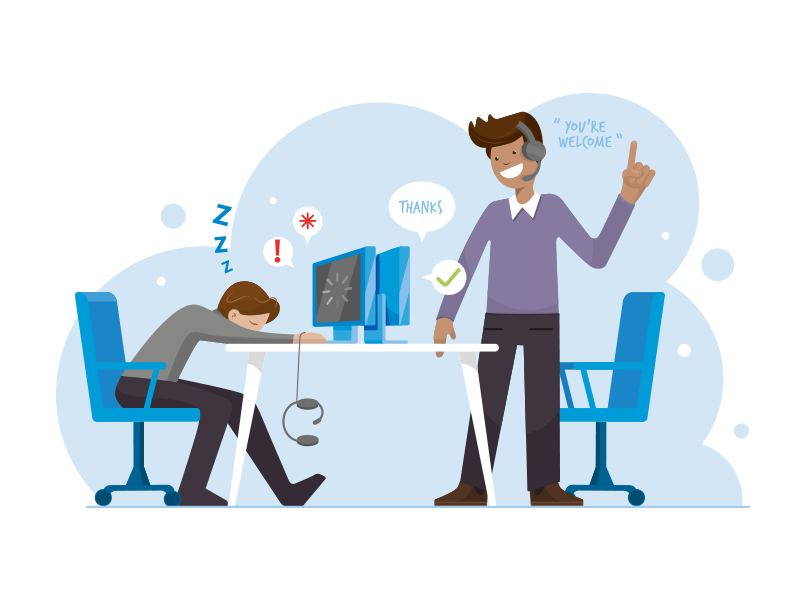5 Things to Save Your Scaling Customer Support Team










Regardless of the size of the company, any scaling Customer Support team needs to set up a framework that is tried and tested to deliver success.
From establishing the right targets, to having the right people in the right roles, industry experts have established these five key factors that can save your scaling Customer Support team:
Many companies start off with focusing on metrics like customer satisfaction or average response times, metrics that directly impact the customer experience. This way, business growth tends to be support driven and from customers’ word of mouth. However, experience shows that when companies get bigger, Customer Support teams focus more on operations.
This can take away the focus on metrics that deliver the best customer experience. You see companies focusing on metrics like agent productivity, the number of tickets an agent is working on and the number of responses they’re able to give every day. Where agents are incentivised to work harder and faster, this does not usually drive good results for the customer experience.
It’s particularly important whilst a business grows, that agents are incentivised on metrics that deliver the best customer experience that helps your company to deliver the best customer experience.
One of the risks of measuring those internal efficiency metrics that don’t directly impact on customer outcomes, is that it can lead to some pretty bad behaviours amongst customer facing colleagues.
| A good example of this is AHT, where you’re measuring the average time it takes an agent to resolve a customer’s query. This forces agents to handle queries faster and can be counterproductive and it invariably leads to customers feeling rushed, often left with incomplete answers. In extreme cases it can even lead to agents hanging up on customers to bring down their average handling time! |
| A better alternative is to measure outcomes such as first contact resolution or repeat contact rate, understanding how many times a customer has to contact you to get their query resolved. |
It can be quite hard sometimes to convince operational leaders and decision makers who are targeted on some of these efficiency metrics. However, when you do convince them, you’re able to demonstrate a measurable reduction in repeat contacts and the downstream cost savings of that will always be greater than the additional upfront costs of removing that type of target. If you’re struggling to convince a decision maker, then it can help to show case studies from other businesses who have taken the leap of faith.

When people perform well, you immediately think that they will be great at taking the next step in their career ladder. However, high performing agents don’t always make the best coaches. Mistakes are amplified in high growth environments where you need to fill roles very quickly. In these types of environments, it’s easiest and fastest to promote high performers to the next level, sometimes with little time to match skills, behaviours or even experience.
The first step to avoid this mistake is recognising how you’re measuring agents. To be a great agent you need to be efficient in how you deal with customers, but you also need to be able to listen, empathise and care.
These same skills are highly desirable when you’re leading and/or coaching a team. These skills don’t come naturally to some people, so if you are largely focusing on efficiency, be really careful. Some of those high performing agents are going to cause a lot of issues for you when they become leaders and are fostering the wrong operational culture.
The next step is around investing in training and coaching for team leaders. They are the people in your organisation who arguably have the most impact on culture and customer loyalty than anybody else, including agents. Another key mistake to avoid is putting high performing agents in charge of teams to cover holidays, maternity or sickness without recognition or reward and without that training and support. This can breed resentment very quickly and it devalues that role.
So, a few vital things to consider:
Some companies deal effectively with this scenario by offering agents two career path options, so if they don’t want to go into operational leadership and coaching, they can still progress in their career but it doesn’t necessarily have to be into a people manager role.
When things are changing so quickly, making sure your agents are up to speed can be a real challenge. Some agents can be receiving thousands of emails each day, so if an important email update comes through that they need to be aware of, whether that is a campaign, or a change in process, it can get lost.
That’s why it’s so important to make sure that every quarter, or at least once a year, you are investing in and checking you have the right communication channels to communicate with agents. Some companies use Workplace by Facebook, or similar platforms to communicate in a way that works best for agents.
Having a communications strategy where agents know exactly where to find their high priority updates that must by read straight away is key.
Collaborative tools like Slack are also great for helping cross functional teams to work together better, with regular, efficient communications instead of sending out emails. Bridging that gap between service teams and product marketing can be really improved by using these kinds of collaborative tools and communication channels.
Consistency is about building confidence, building credibility, trust and brand integrity but it also has quite a strong impact on operational efficiency. It’s about giving customers that confidence to trust what you do.
Particularly when a company is growing, there’s a requirement for having the right processes and policies in place. They drive consistency even when there are so many changes happening.
Consistency starts with observing and measuring how closely agents meet the required standards on their skills, behaviours and process outcomes through QA. There are lots of ways of doing QA, the traditional approaches and the more recent analytics-based QA, which allows you to score 100% of contacts.
It’s about finding ways that blend technology with human intervention to combine the best bits of all approaches to QA, with one of the key outputs being consistency. It is important that every time a customer gets in touch with your company, it feels like it’s one brand, it’s one voice.
When they’ve had good experiences with some people in your team, the next time they speak with you they’re likely to expect the same amount of friendliness, the same quality of support and it becomes even more important for you to focus on the consistency.

Finally, you need to make sure that you don’t forget about your culture. Leaders play key roles in the creation of operational culture and that culture needs to be people focused.
Peter Drucker’s phrase around culture is a really apt one, whereby ‘culture eats strategy for breakfast’ or in other words, if the culture is not right then all of those other initiatives just won’t work.
So, all these previous tips listed above will only work if you get the culture right by creating those cultural codes and the values and what it is to be part of your business. Then it’s about bringing that to life. The operation of a business is really where that culture can come to life and where it can be communicated directly with customers. Investing in your culture is just so important, especially when going through a period of growth.

These five tips and guidance have been provided by a set of industry experts with years of experience in Customer Support and hopefully their insights will enable you to put the right actions in place to save your scaling Customer Support team.
If you’ve enjoyed this blog, check out other content around Customer Support, Quality Assurance and managing Agents on our Knowledge Hub.
